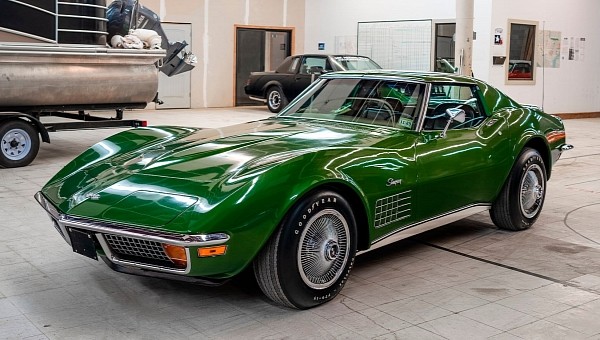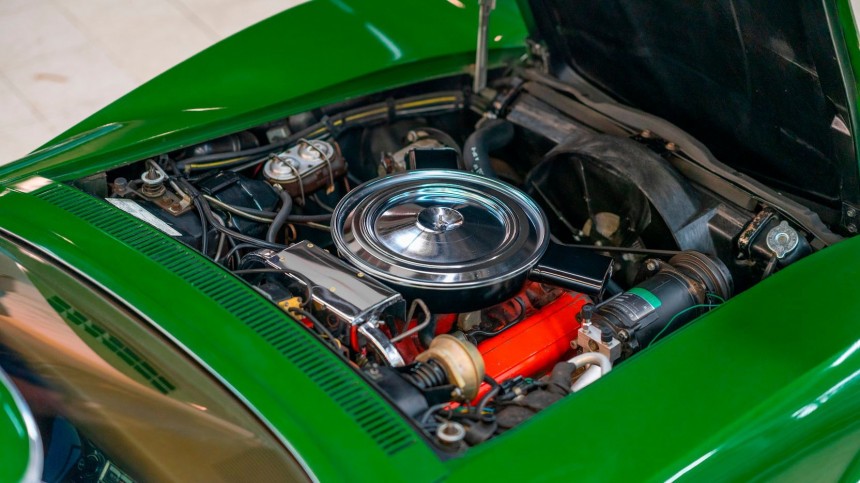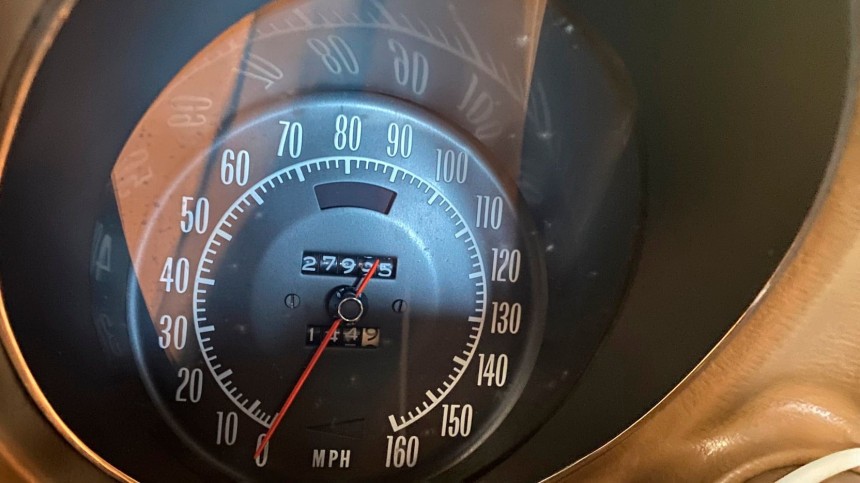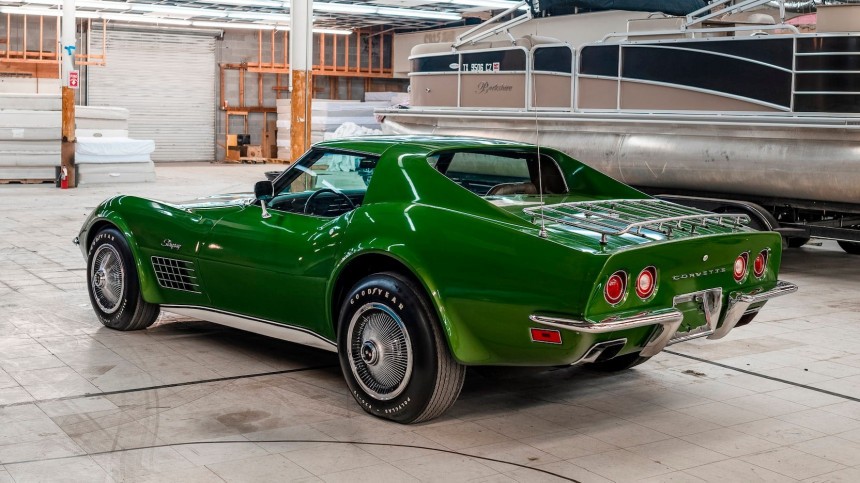This mysterious Corvette emerges unscathed after half a century of glorious, unrestored life that we know almost nothing of except three things. One: the car is a certified survivor, so “you gotta bring some to get some.” Two, it is in pristine condition, as the National Corvette Restorers Society Top Flight award stands solid proof.
And three – and my personal favorite – it is a standing, shouting demonstration that the grass is greener on the V8 side. No socket-sucker in the world today or whenever can even lay in the shadow of this splendid 1972 piece of magnificence. This Bloomington Gold Survivor Certified Corvette is in another league, equipped with the less boisterous 350 CID (5.7-liters) that produced the SAE net rating of 200 hp. 1972 was the first year when engine specs were given in less impressive but more realistic numbers; read more details at the end of the story.
The owner is either very laconic or shy about the possession with which he or she will part ways. The green ‘Vette is going on the block on the Las Vegas auction of November 10-12. The description gives only the basics: engine size, transmission – automatic, by the way, but there is no clue or hint about what type of gearbox it is (the three-speed Turbo-Hydramatic, or the four-speed auto).
But it’s not an uncommon trait for the examples of that year, as 1972 marked the prevalence of automatic over manual choice: GM equipped 54% of its Corvettes with the easy-to-operate transmission assembly.
Apart from the unmistakable Elkhart Green exterior livery, the announcement states “tan” for the interior color. However, the 2018 Bloomington certification winners’ list specifies the shade as “Saddle.” And a closer peek at the rear three-quarter photo shows the top of the passenger seat in a nice tint of brown.
Not that the paint name matters too much since the only way to see it is to go to Vegas (and take a shoot at the casino, win big and take the discrete 1972 Corvette home). The scarcity of photographic enticement is highly unusual, especially for a vehicle sold at an auction.
The announcement says the car is unrestored and comes with the original keys (at a whisker under 28k miles, the keys haven’t seen many engines start-and-stop cycles). The air conditioning is a factory-installed option on this half-a-century young spectacular car. Several documents accompany the vehicle (all original papers): Warranty guard, bill of sale, service records, and window sticker. A Protect-O-Plate comes with the paperwork to testify to the vehicle’s authenticity.
Finally, the car is claimed to have “recently completed thorough mechanical service and inspection.” No further details are given, but a thorough inspection of the photos hints at a Texas provenance. Next to the office door of the garage where the images were taken, there is a lone star sticker, and the boat in the background has a TX registration number.
However, several things can be said about this model year Chevy Corvettes, the longest-lasting production run of the marque’s history, between 1968 and 1982. The 1972 cars were the last to sport front and rear chrome bumpers (they are visible and shiny in the gallery). Supplementary, the ‘72s received the key-actuated antitheft alarm as standard equipment was installed.
Alternatively, while the air conditioning was offered as an optional extra, the removable rear window (the straight-up model) would improve the occupants’ comfort under hot driving conditions. This feature and the vacuum-actuated pop-up windshield wiper door were no longer available after 1972.
A little thing to note is the power rating change that came about in 1972 and saw engines losing as much as 30% of paper-stated output. Several factors coincided with the big-numbers bragging rights of the American car manufacturing industry.
First, the difference in measuring the actual engine output: until 1972, the engine was bench-tested naked – that is, with no power-draining accessories attached, just bare piston force scaling. Beginning with that landmark year, the engine test was performed “as-is,” with all standard accessories attached. Some cars with air conditioning installed lost even more power than their less-optioned siblings.
Second, the emissions regulations were beginning to take a massive toll on the V8 muscle. Adequate exhaust gases-cleaning equipment installed on the cars would further kneel the engine power and torque to levels far below those of previous years. Consequently, the 350 CID V8 that would output 270 hp in 1971 suddenly lost almost 25% of its might in 1972, with the not-so-very-America’s-sports-car-worthy reading of just 200 hp.
With this in mind, the car’s top speed and acceleration were modest: 116 mph (186 kph), 7.1 seconds for the 0-60 mph (0-97 kph) sprint. The quarter-mile jolt was covered in 15.6 seconds, with the terminal velocity across the line of 91 mph (147 kph).
The owner is either very laconic or shy about the possession with which he or she will part ways. The green ‘Vette is going on the block on the Las Vegas auction of November 10-12. The description gives only the basics: engine size, transmission – automatic, by the way, but there is no clue or hint about what type of gearbox it is (the three-speed Turbo-Hydramatic, or the four-speed auto).
But it’s not an uncommon trait for the examples of that year, as 1972 marked the prevalence of automatic over manual choice: GM equipped 54% of its Corvettes with the easy-to-operate transmission assembly.
Apart from the unmistakable Elkhart Green exterior livery, the announcement states “tan” for the interior color. However, the 2018 Bloomington certification winners’ list specifies the shade as “Saddle.” And a closer peek at the rear three-quarter photo shows the top of the passenger seat in a nice tint of brown.
The announcement says the car is unrestored and comes with the original keys (at a whisker under 28k miles, the keys haven’t seen many engines start-and-stop cycles). The air conditioning is a factory-installed option on this half-a-century young spectacular car. Several documents accompany the vehicle (all original papers): Warranty guard, bill of sale, service records, and window sticker. A Protect-O-Plate comes with the paperwork to testify to the vehicle’s authenticity.
Finally, the car is claimed to have “recently completed thorough mechanical service and inspection.” No further details are given, but a thorough inspection of the photos hints at a Texas provenance. Next to the office door of the garage where the images were taken, there is a lone star sticker, and the boat in the background has a TX registration number.
However, several things can be said about this model year Chevy Corvettes, the longest-lasting production run of the marque’s history, between 1968 and 1982. The 1972 cars were the last to sport front and rear chrome bumpers (they are visible and shiny in the gallery). Supplementary, the ‘72s received the key-actuated antitheft alarm as standard equipment was installed.
A little thing to note is the power rating change that came about in 1972 and saw engines losing as much as 30% of paper-stated output. Several factors coincided with the big-numbers bragging rights of the American car manufacturing industry.
First, the difference in measuring the actual engine output: until 1972, the engine was bench-tested naked – that is, with no power-draining accessories attached, just bare piston force scaling. Beginning with that landmark year, the engine test was performed “as-is,” with all standard accessories attached. Some cars with air conditioning installed lost even more power than their less-optioned siblings.
Second, the emissions regulations were beginning to take a massive toll on the V8 muscle. Adequate exhaust gases-cleaning equipment installed on the cars would further kneel the engine power and torque to levels far below those of previous years. Consequently, the 350 CID V8 that would output 270 hp in 1971 suddenly lost almost 25% of its might in 1972, with the not-so-very-America’s-sports-car-worthy reading of just 200 hp.











